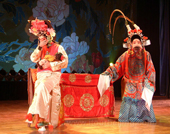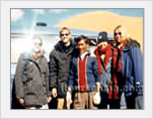
Chinese Singing and Dancing

According to the discovery of a bone flute in Neolithic Age, Chinese music can be originated from about 8000 years ago. In the Xia, Shang and Chou Dynasties, only royal and officials listened to music played on chimes. By the Tang Dynasty, sing and dancing became popular, spreading from royal families to common citizens. With the introduction of Buddhism and Islam, religious music were absorbed and enjoyed by the Chinese people. In the Song Dynasty, Zaju and Nanxi were showed in theatres and teahouses. Writers and artists liked them so much that a new type of literature resembling lyrics called Ci thrived. During the Yuan Dynasty, Qu, another type of music became popular.
 During the Dynasties of Ming and Qing, Chinese traditional opera art developed quickly and variously in different areas. When these distinctive opera styles were performed in Beijing, artists combined the essence of the different styles and created Beijing opera, one of three cornerstones of Chinese culture which continue to be appreciated even in modern times.Besides these types of music, Chinese farmers were clever enough to write folk songs, which also developed severally with local flavor. Folk songs described working and daily life such as fishing, farming, and herding and were very popular among the populace.
During the Dynasties of Ming and Qing, Chinese traditional opera art developed quickly and variously in different areas. When these distinctive opera styles were performed in Beijing, artists combined the essence of the different styles and created Beijing opera, one of three cornerstones of Chinese culture which continue to be appreciated even in modern times.Besides these types of music, Chinese farmers were clever enough to write folk songs, which also developed severally with local flavor. Folk songs described working and daily life such as fishing, farming, and herding and were very popular among the populace.
 The art of Chinese dance can be traced back to before the first written Chinese characters. It was divided into two kinds, civilian dance and military dance, during the Shang and Chou dynasties. In civilian dance, dancers held feather banners in their hands, symbolizing the distribution of the fruits of the day's hunting or fishing. In the military dance, dancers carried weapons in their hands, and moved forward and backward in coordinated group motion. After the formation of the Music Bureau in the Han Dynasty, active efforts were made to collect folk songs and dances. In this way, folk dance forms of the various peoples of Central Asia were introduced into China, and merged with the original dances of the Han people. This pattern continued well into the Tang Dynasty. Because of the stability of the state power during the Tang Dynasty, dance in China went into an unprecedented prosperity. The Tang Dynasty imperial court founded the Liyuan Garden Academy, gathering the top dancing talent of the country to perform the magnificent "Ten Movement Music" dance. This dance unified elements from dance forms of the peoples of China, Korea, India, Persia, and Central Asia into one stupendous dance. Each minority group of China also has its own folk dance forms. For example, the Miao people of southwestern China developed a lively style of antiphonal singing and competitive dance. Folk dances directly reflect the lifestyles and customs of a people, and in addition to their artistic value as dances, they are a precious part of China's cultural heritage.
The art of Chinese dance can be traced back to before the first written Chinese characters. It was divided into two kinds, civilian dance and military dance, during the Shang and Chou dynasties. In civilian dance, dancers held feather banners in their hands, symbolizing the distribution of the fruits of the day's hunting or fishing. In the military dance, dancers carried weapons in their hands, and moved forward and backward in coordinated group motion. After the formation of the Music Bureau in the Han Dynasty, active efforts were made to collect folk songs and dances. In this way, folk dance forms of the various peoples of Central Asia were introduced into China, and merged with the original dances of the Han people. This pattern continued well into the Tang Dynasty. Because of the stability of the state power during the Tang Dynasty, dance in China went into an unprecedented prosperity. The Tang Dynasty imperial court founded the Liyuan Garden Academy, gathering the top dancing talent of the country to perform the magnificent "Ten Movement Music" dance. This dance unified elements from dance forms of the peoples of China, Korea, India, Persia, and Central Asia into one stupendous dance. Each minority group of China also has its own folk dance forms. For example, the Miao people of southwestern China developed a lively style of antiphonal singing and competitive dance. Folk dances directly reflect the lifestyles and customs of a people, and in addition to their artistic value as dances, they are a precious part of China's cultural heritage.
Your Question & Quick Answer*We welcome and appreciate your questions & reviews
Booking Procedures | Terms & Conditions | Payment Methods | Links | Site Map | About Us | Contact Us | Travel Agent
Copyright 2008, All rights reserved.. itourbeijing.com ,china culture, china introduction
TEL: 86-10-85711972 (Universal) 1-888-288-9328 (North America) E-mail: contact@itourbeijng.com
Home | China Tours | Beijing Tours | Tibet Tours | China Travel | Beijing Travel | Shanghai Travel



